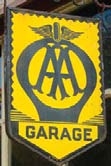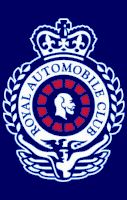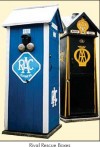What’s On your Badge-Bar? The British Motoring Clubs

 Following is an article which recently appeared in the MGA! magazine written by Roger Bailey, NAMGAR Member.
Following is an article which recently appeared in the MGA! magazine written by Roger Bailey, NAMGAR Member.
Many enthusiasts like to make their MGs just that bit more ‘British’ by equipping ‘the old girl’ with badges of the two British motoring clubs. Displaying such badges is very appropriate: the AA and RAC have been an important part of British motoring for over a century and remain so to this day. At the time our MGAs were made, rescue call boxes had long been a fixture of the countryside, along with the uniformed servicemen they summoned. Increasingly reliable cars and better communications began to reduce the need for the boxes, the final demise brought on by the advent of mobile phones. But, motorists still rely on the clubs’ roadside assistance, along with a vast array of other services. AA and RAC logos appear on everything the traveler sees, from hotel signs to repair garages, on maps and special event signs and even on some early legacy signposts.
Other than our favorite octagon, which has never needed its image or message refreshed, most symbols seem to undergo a periodic ‘facelift,’ and even Rolls Royce’s “Spirit of Ecstasy” had her shapely form restyled. Similarly, club logos have changed over the years, with badges attracting both vintage car owners and automobilia collectors. Fortunately, you don’t have to worry about ‘correctness’ when adding a club badge to your MGA because drivers sometimes maintained their club memberships for decades, transferring the badge from car to car, so an outdated badge was not that uncommon. Furthermore, a newly joined member might well place his or her new badge onto an older car. So, in the words of Cole Porter “Anything Goes.”
Anyone familiar with the post-war British driving scene might assume that roadside rescue was the primary purpose of motoring clubs. Indeed, a motorist not adept at repairing his car could expect to be stranded miles from anywhere. But, maintaining an effective roadside service requires a huge investment in well-staged facilities, service vehicles, trained manpower, and communications – something only a large membership could fund, and although a primitive roadside recovery system was devised as early as 1901, roadside rescue boxes didn’t make their appearance until 1912.
Meanwhile, the Automobile Club began lobbying for increased speed limits in 1903, and pressing to alter regulations created in the age of the horse. In 1905, it pioneered driving ‘certificates,’ the practice enduring for thirty years until made obsolete by government-issued licenses. Changing regulations and re-directing taxes to fund road projects require considerable social ‘leverage,’ and only people ‘of means’ could achieve such things. Indeed, early drivers/ club members typically came from well connected and well off families with just such influence. Nevertheless, altering laws is one thing, funding comprehensive services is quite another.
The Automobile Club of Great Britain was founded in 1897 by Messrs Simms and Moore, who based its constitution on that of the Automobile Club of France. The new constitution also became the basis for an equivalent club in Ireland, later amalgamated to form the Automobile Club of Great Britain and Ireland. Since the ‘players’ of the day must have been able to ‘pay,’ it is not surprising the club enjoyed some pretty fancy ‘digs’ in London. Initially located in Whitehall, it was never far from the seat of government, and, after relocating to Piccadilly in 1902, it made its final move in 1911, occupying some disused war offices in Pall Mall within sight of the Palace!
At the time, even if the common man could have afforded a car, and been able to afford the price of admission to the club, probably had little chance of acceptance: hob-knobbing with members of the ultimate in exclusivity, ‘the Victorian ruling class’ was ‘just not on [the cards], old chap.’ WWI would change all that, but, meanwhile, the fascination with automobiles was growing at all levels of society.
As a point of interest, the North American “Triple A” developed quite differently: founded in 1902 by a consortium of nine independent clubs seeking road development and improvement, AAA grew by affiliating numerous independents, including the Canadian Automobile Association.
 Automobile Club member Claude Johnson organized the first 1000-mile trial in 1900, thereby demonstrating the reliability of the new ‘horseless carriage.’ Five years later the club sponsored the first Tourist Trophy (TT) race, further capturing the interest of King Edward VII, a great motoring enthusiast. Famously, cars were one of two maor interests in Edward’s life (the other being the ladies) and in 1907 the king gave the royal assent to the Automobile club, following which it was known as the Royal Automobile Club. By 1928, a growing number of people could afford a car (which could soon included an MG), and public interest had become strong enough for the RAC to sponsor the first British Grand Prix at the now-famous Brooklands Racetrack. If you consult Michael Ellman-Brown’s marvelous Complete Guide to MG Collectables, on page 154, you can see the medallion issued by the RAC in 1931 to commemorate the first Irish Tourist Trophy, won in that year by MG driver S.A. Crabtree, at a speed of 67.62mph! The RAC’s influence on MG, and on motor sports in general, is well described in the excellent DVD Inside the Octagon.
Automobile Club member Claude Johnson organized the first 1000-mile trial in 1900, thereby demonstrating the reliability of the new ‘horseless carriage.’ Five years later the club sponsored the first Tourist Trophy (TT) race, further capturing the interest of King Edward VII, a great motoring enthusiast. Famously, cars were one of two maor interests in Edward’s life (the other being the ladies) and in 1907 the king gave the royal assent to the Automobile club, following which it was known as the Royal Automobile Club. By 1928, a growing number of people could afford a car (which could soon included an MG), and public interest had become strong enough for the RAC to sponsor the first British Grand Prix at the now-famous Brooklands Racetrack. If you consult Michael Ellman-Brown’s marvelous Complete Guide to MG Collectables, on page 154, you can see the medallion issued by the RAC in 1931 to commemorate the first Irish Tourist Trophy, won in that year by MG driver S.A. Crabtree, at a speed of 67.62mph! The RAC’s influence on MG, and on motor sports in general, is well described in the excellent DVD Inside the Octagon.
All motorists share similar needs and interests, and as larger membership rolls were the key to higher revenues and expanded services – not to mention pressure from any competitor organizations – it became obvious that RAC must allow two classes of membership; full members and, well, not full members; those who desired only travel-related services. The London club was not for everyone: even if a middle-class driver lived within range of ‘the city’ and could afford London club amenities, he might well feel out of place.
You get a feel for what things must have been like decades ago at RAC by reading the London club’s brochure. If deemed worthy and having made it off the waiting list, the joining fee in 2003 was about $2,500, which entitled you to buy dinner at the club, sport your radiator badge and purchase, with any pocket-change left over after the $1,300 annual membership fees, any of the other club offerings. For example, having secured an annual mid-week golfing pass for $750, you could join the waiting list for the all-week pass, available for only $250 more. Naturally, as with any exclusive club, ‘being deemed worthy’ requires that you know how to, and are willing to, abide by all the rules, regulations, and customs. For instance: “Jacket and tie will be worn – absolutely NO cravats (‘windsors’) are permitted”! There is no need to elaborate further, as this entire scene is, doubtless, quite familiar to most members of NAMGAR!
 The member’s handbook mapped all numbered call box locations from which, with the aid of a club key, the driver could telephone for help. If the car couldn’t be driven to the box, a passing fellow member would often oblige, but, failing all else – provided you were on a major road – you could expect a serviceman to come along within an hour or two.
The member’s handbook mapped all numbered call box locations from which, with the aid of a club key, the driver could telephone for help. If the car couldn’t be driven to the box, a passing fellow member would often oblige, but, failing all else – provided you were on a major road – you could expect a serviceman to come along within an hour or two.
Breakdown service patrols relied on small vans and motorcycle-sidecars filled to capacity with spare parts and equipment. Rescue boxes were larger than the standard red telephone box, being designed to offer limited shelter from the weather, yet smaller than the blue police box made famous by the TV series Dr. Who (come to think of it, they were many orders of magnitude smaller than the interior of the Tardis!). Sadly, all of these iconic boxes have virtually disappeared from Britain.
Created at a time when one’s chauffeur would be dressed in quasi-military dress, the clubs dressed their personnel in military-style uniforms. Distinctive colors differentiated the servicemen and their equipment from the competition: the RAC adopted a blue similar to the RAF uniform, whilst the AA adopted a tan color evocative of the army, and having yellow accents. Just as the family chauffeur would touch his cap in deference to his employers, the servicemen were trained to honor passing members with a salute smart enough for the fiercest regimental sergeant major. It was all part of the mystique.
Even in older, slower, days servicemen were occasionally injured or killed while performing their duties, so, given the speed and density of UK traffic, one can’t begrudge the serviceman his fluorescent jacket. But even if smart uniforms have given way to serviceable (and inexpensive) garb, it appears from Internet chatter that members still expect a salute and tend to ‘carry on something awful’ if they don’t get one. The fact that they do this is confirmation that deferential treatment is as highly prized as ever, with drivers still enjoying the boosting of both batteries and egos!
Although servicemen would be watching primarily for any club members in distress, there were many press reports of them lending a hand to non-members. In fact, my family was treated to such help when our Austin Cambridge broke down with ignition problems and we were ‘rescued’ by a passing AA serviceman. Faulty condenser replaced, the man politely declined dad’s offer of ‘have one on me,’ responding instead with the counter-offer of a membership form and brochure!
The structure of RAC has changed dramatically over the last decade: its service business had grown large and profitable, and expanded beyond simply listing driving schools to actually buying out BSM, Britain’s most recognized driving school. Meanwhile, Lex Services, a firm involved in everything from parking garages to rental fleet operations acquired Multi-Part, and thereafter decided that auto parts and products should be their core business. RAC, with its array of services was a natural target for Lex, so in 1999, Lex bought the motoring services division from The Royal Automobile Club, naming their purchase “RAC Plc.” The London club, presumably with its coffers now as full as its wince cellars, continued on, rather confusingly, using their original chartered name: “The Royal Automobile Club.”
In 2005 RAC Plc was sold to the Aviva insurance giant for £1.1 billion, providing club members with an array of insurance services, and the parent company with a large pool of potential clients. At the time, the BBC reported that RAC plc had “about 6.7 million roadside assistance customers, and about 275,000 motor and home policy-holders under the RAC Insurance brand.” Along the way, the RAC roadside rescue vans changed color from blue to orange.
Together with its continuing involvement in motor-sports, RAC Plc pursues topics of importance to drivers of vintage cars, lobbying for continued availability of leaded petrol whilst simultaneously, in partnership with the Federation of British Historic Vehicle Clubs (FBVHC), the testing of lead replacement products. Their travel services continued to expand in both scale and scope, now encompassing hotel rating, location, and reservations, legal services, registration checking, and travel advisories; stolen vehicle recovery, brokerage services for the transfer of ‘desirable’ license plates, driver training, insurance, financing, leasing, and issuing advisories on crucial topics. The latter activities include the infamous London Congestion Charge and, more recently, the promotion of “Green Wave” traffic light sequencing. Other activities include environmental matters, safety, and courteous driving campaigns.
The RAC’s competitor, The Automobile Association, was founded in 1905, partially in reaction to an increasing number of fines due to measured-mile speed traps which it attacked by publishing their locations. By 1908, AA was certifying and listing repair shops (garages), promoting safety, and seeking to provide services not available from the RAC, including legal assistance for members accused of motoring offenses. Just as the RAC had provided road signposting, the AA became known for its temporary signage to special events, as shown in “AA Event Signage.” The new club became popular very quickly, with membership rising to 83,000, in just nine years!
During the 1920s, pre-purchase and post-accident inspection services were added, and AA roadside rescue also became increasingly competitive with RAC. Soon the AA was generating over 250,000 route guides and maps a year – some complete with hand-written notes – and, like their competitor, rating hotels and restaurants. This has continued to the present day, with AA claiming to be the U.K.’s largest travel publisher, having more than 10,000 hotel and restaurant listings.
After WWII, it was the AA who lobbied for an end to petrol rationing, until that goal was achieved in 1950. A year later, with some ‘free ink’ provided by The Illustrated London News, the club rolled out (sorry!) another service ‘coup:’ radio-controlled (dispatched) service vans! The club continues its involvement in a variety of motoring issues-de-jour, from the use of seatbelts, to opposing ‘unfair’ motoring taxes and lobbying for road improvements.
As with the RAC, AA’s success became a business opportunity for Centrica Corp., which purchased the club in 1999 for ₤1.2 billion. In 2000, they also acquired Halfords, a nationwide parts retailer, thereby creating 150 branded products, and then creating an on-line car buying service. Although the era of roadside boxes has passed, AA continued to improve its service response time and the effectiveness of its breakdown services, recently receiving “ #1” ratings by both J.D. Power and Which magazine (the U.K.’s version of Consumer Reports). AA membership currently stands at around 15 million! High-tech, on-line services, blogging and twittering, does not, in my opinion, replace personal contact, particularly in the form of the iconic roadside rescue.
High quality original club badges can command a good price, with rare, early badges such as the RAC Full Member badge costing hundreds of dollars. As good original badges become harder to find, reproductions have become available – not all of which are authentic in appearance. You can check for authenticity and compare badge designs from the Beaulieu photos shown in “AA Badges,” “MGA onwards badges,” and “Earlier RAC badges.” The club badges issued during MGA production years are isolated in “MGA period badges.”
The two major British motoring clubs, The RAC and the Automobile Association endure as they have for more than a century by adapting to the needs of the motorist. So, you can proudly display their badges on your MG, knowing the contribution these two clubs have made to motoring over the last 100 years, not to mention the many MG owners that must have been rescued in that time!


Comment by: David J Stebbing
I remember growing up in England in the 50’s and 60’s and driving with my Grandfather or Father and spending the whole trip looking out for the AA Man so I could salute him as he passed on his Motor Bike.